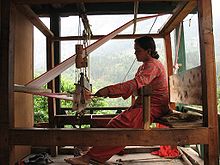Process and terminology
Main articles: Loom and Power Loom
In general, weaving involves using a loom to interlace of two sets of threads at right angles to each other: the warp and the weft (older woof). One warp thread is called and an end and one weft thread is a pick The warp threads are held taut and in parallel order, typically in a loom of which there are many different types. [5] Weaving can be summarised as a repetition of these three actions.
- Shedding: where the ends are separated by raising or lowering heald frames (heddles) to form a clear space where the pick can pass
- Picking:where the weft or pick is propelled across the loom by an air-jet, a rapier or a shuttle
- Beating-up or battening: where the weft is pushed up against the fell of the cloth by the reed. [6]
The principal parts of a loom are the frame, the warp-beam or weavers beam, the cloth-roll, the heddles, and their mounting, the reed. The warp-beam is a wooden or metal cylinder back of the loom on which the warp is wound. The threads of the warp extend in parallel order from the warp-beam to the front of the loom, and are attached to the cloth-roll. Each thread or group of threads of the warp passes through an opening (eye) of a heddle. The warp threads are separated by the heddles into two or more groups, each controlled and automatically drawn up and down by the motion of the heddles. In the case of small patterns the movement of the heddles is controlled by “cams” which move up the heddles by means of a frame called a harness; in larger patterns the heddles are controlled by a dobby mechanism, where the healds are raised according to pegs inserted into a revolving drum. Where a complex design is required, the healds are raised by harness cords attached to a Jacquard machine. Every time the harness (the heddles) moves up or down, an opening (shed) is made between the threads of warp, through which the pick is inserted.[7][6]
On a conventional loom, the weft thread is carried on a pirn, in a shuttle that passes through the shed. A handloom weaver would propel the shuttle by throwing it from side to side with the aid of a picking stick, on a power loom the "picking΅ is done by rapidly hitting the shuttle from each side using an overpick or underpick mechanism controlled by cams. This will happen at between 80-250 times a minute.[6] When a pirn is deplete, it is ejected from the shuttle and replaced with the next pirn held in a battery attached to the loom. The rapier-type weaving machines do not have shuttles, they propel the weft by means of small grippers or rapiers that pick up the filling thread and carry it halfway across the loom where another rapier picks it up and pulls it the rest of the way.[8] Some carry the filling yarns across the loom at rates in excess of 2,000 meters per minute. Manufacturers such as Picanol have reduced the mechanical adjustments to a minimum, and control all the functions through a computer with a graphical user interface.Other types use compressed air to insert the pick, and others small projectiles. They are all fast, versatile and quiet.[9]
The loom is warped ( loomed or dressed) with the warp threads passing through heddles on two or more harnesses. The warp threads are moved up or down by the harnesses creating a space called the shed through which the pick will pass.
The raising and lowering sequence of warp threads in various sequences gives rise to many possible weave structures:
- plain weave: plain, and hopsacks, poplin, taffeta, poult and grosgrain..[10]
- twill weave: these are described by weft float followed by warp float, arranged to give diagonal pattern. 2/1 twill, 3/3 twill, 1/2 twill. These are softer fabrics than plain weaves. [4],
- satin weave: satins and sateens, [11]
- complex computer-generated interlacings.
- pile fabrics : such as velvets and velveteens [11]
Both warp and weft can be visible in the final product. By spacing the warp more closely, it can completely cover the weft that binds it, giving a warp faced textile such as repp weave.[10]Conversely, if the warp is spread out, the weft can slide down and completely cover the warp, giving a weft faced textile, such as a tapestry or a Kilim rug. There are a variety of loomstyles for hand weaving and tapestry. In tapestry, the image is created by placing various colors of weft only in certain warp areas, rather than across the entire warp width.



No comments:
Post a Comment